Feature Articles - Women and WWI - Women at the Front: Been There, Done That
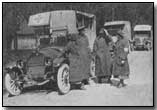 During the war women were to be
found mostly at the home front while a minority went close to the actual fronts
where the war was being fought, some even into combat.
During the war women were to be
found mostly at the home front while a minority went close to the actual fronts
where the war was being fought, some even into combat.
The only woman soldier enlisted in the British Army managed the feat by passing herself off as a man. Dorothy Lawrence, a 20-year-old ambitious journalist, joined in 1915 the B.E.F. Tunnelling Company using the alias Denis Smith, aided by some sympathetic men. She gave herself in after only 10 days worried about the safety of these men and had to endure an absurd interrogatory, as the authorities assumed she was a 'camp follower', that is to say, a prostitute, a term she misunderstood.
While she was forced to keep her adventure silent, as the British Army very much feared the ridicule it would plunge them into, another Englishwoman, Flora Sandes, published a book on her experiences as a soldier in the Serbian Army in 1916, with a view to raising funds for her brothers in arms. Sandes was initially an ambulance driver on the Eastern Front but managed to enlist with the Serbs, who by 1916 had already promoted her to sergeant-major. She stayed on after the war with the Serbian army eventually becoming a major.
Supposedly, Sandes was accepted by the Serbs as the personification of British war aid, a symbolic value also attached though in another sense to no doubt the most famous female combatant of the Great War: the Russian Maria Bochkareva. A soldier in the Army since 1914, wounded and decorated several times, Bochkareva convinced the revolutionary leader Alexander Kerensky in 1917 that a battalion made exclusively of women would shame men grown diffident about the war into fighting.
She recruited 2,000 women out of which about 250 saw actual combat on the Austrian Front fighting together with units of male soldiers. In contrast, the Cossack Maria Yurlova, active in Armenia against the Turkish Army, saw her participation in the war rather as an adventure, though it cost her in the end a severe breakdown.
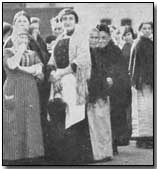 Despite these exceptions the
Governments involved in the war did as much as possible to prevent women's
enlisting and participation in combat out of patriarchal principles.
Despite these exceptions the
Governments involved in the war did as much as possible to prevent women's
enlisting and participation in combat out of patriarchal principles.
These identified man with the warrior knight and woman with the damsel in distress to be protected from the bestial foe, a plainly anachronistic stance in a situation in which technological warfare was already taking the first steps into civilian mass slaughter at the home front, as could be seen with the first zeppelin raids, which caused 1414 deaths.
Women were assumed to be far more helpless than they were and were also forced to assume a helplessness they didn't feel. Besides, in plain military terms, there's more sense in sending to the front the citizens physically most fit of any sex rather than only men. There are abundant comments about the physical unfitness of the last batches of conscripts, many of them working-class men with bodies badly affected by the horrors of industrial work or youths with very little capacity to endure the hardships of the front. Meanwhile, thousands of women as capable as Sandes and Bochkareva were kept away from the front out of sheer sexist prejudice.
In a great show of hypocrisy, the British Army did not welcome the women who ventured near the front to fight or to cover the war as journalists but was quite willing to exploit the labour offered by those who volunteered to write government-sponsored war propaganda, to collaborate with auxiliary medical organisations, or to take up 'soft jobs' in the armed forces.
Mrs. Humphrey Ward, for instance, asked by Lord Curzon to preside the newly-founded Anti-Suffrage League in 1908, was years later taken on a tour of the trenches out of which she published diverse propaganda books intended to stir American sympathy for the Allied war effort. Self-exiled in France, American writer Edith Wharton toured a number of military hospitals on the Western Front sponsored by the French Red Cross, and also battlefields like Verdun with General Joffre's blessings.
Wharton's subsequent energetic fund-raising for refugees earned her in 1916 a decoration as Chevalier of the Legion of Honour. Another American, Mary Borden, a wealthy woman living in England when the war broke out, was awarded a Croix de Guerre for setting up a mobile hospital unit on the Western Front that nursed men wounded in Ypres and the Somme. Interestingly, she did so out of frustration with the incompetence of the French Red Cross, for which she had originally volunteered.
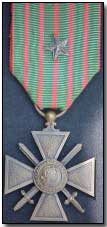 She published in 1929 an
impressive novel, The Forbidden Zone, that reflects her raw experiences.
One of the professional nurses she employed, Ellen La Motte, would also publish
in 1916 an appalling account of her front-line nursing in Belgium, The
Backwash of War: The Human Wreckage of the Battlefield as Witnessed by an
American Hospital Nurse.
She published in 1929 an
impressive novel, The Forbidden Zone, that reflects her raw experiences.
One of the professional nurses she employed, Ellen La Motte, would also publish
in 1916 an appalling account of her front-line nursing in Belgium, The
Backwash of War: The Human Wreckage of the Battlefield as Witnessed by an
American Hospital Nurse.
Nurses had been part of the military set up since the establishment of the Voluntary Aid Detachment (V.A.D.) in 1909 by Lord Kitchener, which formalised the trend initiated by Florence Nightingale during the Crimean War (1853-4) and overlapped with work by the International Red Cross in some cases.
Nightingale's crusade to have soldiers receive proper nursing as close as possible to the battlefield was first rejected as an improper female interference in army life but by the time WWI began this view was changed for good. The International Red Cross, founded in 1863 by the Swiss businessman Henry Dunnant, worried like Nightingale about the low standards of army nursing, was responsible for the signing of the Geneva Convention (or Convention for the Amelioration of the Condition of the Wounded in Armies in the Field) in 1864, the first international agreement to accept the idea that soldiers needn't die needlessly in the battlefields if wounded or sick.
The ICR acted during WWI as an umbrella organisation to which volunteers and organisations similar to today's NGOs attached themselves: it was awarded the Nobel Prize for Peace in 1917, the only occasion it was given during the war. No doubt among those who worked at one time or other for the Red Cross, British nurse Edith Cavell stands our as one true war heroine. She was executed in 1915 by the Germans for having helped literally hundreds of soldiers of the Allied forces to escape from the Belgian hospital she ran to the Netherlands.
While nurses and ambulance drivers (another novelty of the war) were fully accepted, female doctors were quite another matter. Elizabeth Blackwell (awarded a degree by the Geneva Medical School in 1849 and the first female MD to qualify in the USA) and Sophia Jex-Blake (qualified in 1877 as a doctor by the Irish College of Physicians) differed from Nightingale in that they believed women's jobs in the field of medicine needn't be limited to nursing.
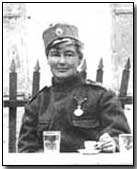 Although almost 40 years had
passed since Jex-Blake's graduation,
Dr. Elsie Inglis,
a graduate from the Edinburgh School of Medicine for Women she had founded and
who eventually founded her own medical college, faced a hard time when she
offered to take women's medical units to the Front. The Scottish Women's
Hospital Unit was set up by Inglis with the help of politician Violet
Douglass-Pennant and playwright Cicely Hamilton among other feminists, and
counted among its collaborators with Ishbel Ross and
Evelina Haverfield,
founder of the Women's Emergency Corps (1914) and collaborator with Flora Sandes
in the setting up in 1918 of canteens that served thousands of Serbian soldiers.
Although almost 40 years had
passed since Jex-Blake's graduation,
Dr. Elsie Inglis,
a graduate from the Edinburgh School of Medicine for Women she had founded and
who eventually founded her own medical college, faced a hard time when she
offered to take women's medical units to the Front. The Scottish Women's
Hospital Unit was set up by Inglis with the help of politician Violet
Douglass-Pennant and playwright Cicely Hamilton among other feminists, and
counted among its collaborators with Ishbel Ross and
Evelina Haverfield,
founder of the Women's Emergency Corps (1914) and collaborator with Flora Sandes
in the setting up in 1918 of canteens that served thousands of Serbian soldiers.
Knowing that Inglis's main sponsor was the National Union of Women's Suffrage Societies (NUWSS), an organisation with a marked pacifist bent, it comes as no surprise that the War Office didn't sympathise with Inglis's offer to work near the front lines, and so told her that the least wanted persons there were 'hysterical women'.
The efforts of the Women's Hospital Corps founded by Dr. Louisa Garrett and Dr. Flora Murray were greeted with the same coldness, though the men of the French Red Cross were fortunately more receptive and these two women were able to open military hospitals in Paris and near Bolougne before one in London was finally authorised. The Belgians were also sympathetic towards the Women's National Service League founded by Lady Muir McKenzie and suffragist Mabel Stobart, who already had experience in the Balkan War of 1912 with the Women's Sick and Wounded Convoy Troops.
Stobart founded a hospital in Belgium staffed exclusively by women and moved later back to the Balkans to resume hospital work there. As for Inglis, she took nonetheless her hospital units first to France in 1915 and subsequently to Serbia - where she was briefly held captive by the Austrians - Corsica, Salonika, Romania, Russia and Malta. Ironically, as happened in the case of Flora Sandes, the women under Inglis's command and other nurses like Florence Farmborough - who escaped from Siberia to the USA with Maria Bochkareva, the famous head of the Women's Death Battalion - were seen as symbols of Britain's deep involvement in helping her allies.
The same can be said of Americans such as Helen Fairchild, one in a group of Pennsylvania volunteers who staffed a unit at Passchendaele as soon as the USA became involved in the war, and who lost her life there possibly due to the effect of mustard gas.
VADs needn't be women but most were. Between 1914 and 1918 about 38,000 worked as auxiliary nurses, ambulance drivers and cooks both in the hospitals of the home front and the units of the Western front under the stern rule of Commander-in-Chief Katharine Furse, the woman who took the first VAD units to France.
 This was not immediate as, ridiculous as this may seem, VADs were only
allowed near the front lines in 1915 provided they were over 23. They worked,
besides France, in the Eastern Front, Mesopotamia, Gallipoli and Malta. Proof of
the Victorian absurdities operating against VADs can be found in
Vera Brittain's
brilliant book of memoirs Testament of Youth (1933), a volume in which she
describes in singular detail the gruelling working conditions that naive
middle-class girls like her were subjected to.
This was not immediate as, ridiculous as this may seem, VADs were only
allowed near the front lines in 1915 provided they were over 23. They worked,
besides France, in the Eastern Front, Mesopotamia, Gallipoli and Malta. Proof of
the Victorian absurdities operating against VADs can be found in
Vera Brittain's
brilliant book of memoirs Testament of Youth (1933), a volume in which she
describes in singular detail the gruelling working conditions that naive
middle-class girls like her were subjected to.
Young women who had been raised with all the restrictions of a Victorian education for ladies suddenly found themselves in strange intimacy with each other - putting up with cold rooms, nasty food and low hygiene standards - and also in shocking familiarity with shattered male bodies. Brittain complains how, far from being welcome, VADs were constantly under the suspicion by professional nurses of being intruders after their jobs, which they certainly were not.
Brittain writes that the reason why she joined in was sympathy for the ordeal of her fiancé at the front; in her diary she wrote: "He has to face far worse things than any sight or act I could come across; he can bear it - and so can I" (154). She adds, though, that "Truly the War had made masochists of us all" (154).
Other VADs who left a critical testimonial are Enid Bagnold in Diary without Dates (1917) and Helena Zenna Smith (the penname of Evadne Price) in her remarkable novel Not So Quiet: Stepdaughters of War (1930), written in quick response to Erich Maria Remarque's best-seller All Quiet on the Western Front (1929).
The VADs were actually created after the FANYs (First Aid Nursing Yeomanry), another brainchild of Lord Kitchener, set up in 1907. FANYs were used during the Great War in dangerous ambulance driving between the front line and field hospitals that they also ran - a feat for which they received quite a high number of decorations - but also for cooking and keeping canteens.
Both FANYs and VADs were the seed for other auxiliary corps also created by men that, to put it crudely, recruited women into serving the basic needs of the army, navy and air men. The main idea behind this strategy was freeing the men from the need to be employed in service jobs behind the front lines while giving women the illusion they were part of the armed forces. According to Prof. Joanna Burke (Women and the Military during World War One, BBC), "in World War One, approximately 80,000 women served in the three British women's forces as non-combatants."
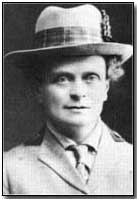 The Navy set up in 1916 the Women's Royal Navy Service (WRNS) staffed by women
running kitchens, postal and phone communications, and the administration. The
link with the VADs becomes obvious if we think that Katherine Furse was
appointed director in 1917, when she resigned as VAD Commander in Chief. The
Women's Army Auxiliary Corps (WAAC) followed in 1917 at the instigation of
Lieut. Gen. Sir Henry Lawson, and was filled with volunteers without full
military status even though they were subjected to German enemy fire all through
their activities in France.
The Navy set up in 1916 the Women's Royal Navy Service (WRNS) staffed by women
running kitchens, postal and phone communications, and the administration. The
link with the VADs becomes obvious if we think that Katherine Furse was
appointed director in 1917, when she resigned as VAD Commander in Chief. The
Women's Army Auxiliary Corps (WAAC) followed in 1917 at the instigation of
Lieut. Gen. Sir Henry Lawson, and was filled with volunteers without full
military status even though they were subjected to German enemy fire all through
their activities in France.
WAACs, commanded by the efficient Helen Gwynne-Vaughan, were victims of a sexist campaign claiming that a significant number of them had been made pregnant at the front though an official investigation proved this was false, the exceptions being very few for such a large group of women. The Women's Royal Airforce (WRA) came last in 1918 first under the command of Lady Crawford, who soon resigned annoyed by the lack of actual power the military had granted her, a situation her successor Violet Douglass-Pennant also complained of at the time of her own dismissal; she was replaced by Gwynne-Vaughan, the best administrator these organisations ever had.
Gwynne-Vaughan, a reputed mycologist, and Douglass-Pennant, a practised politician, and Katherine Furse were women of exceptional skills as administrators and it's a sign of the narrow-mindedness of the the British Government that they were given just a little corner to work on when their abilities could have been made the best of in positions of higher responsibility, including the Cabinet itself.
The USA, the country in which women have the longest record of presence in combat with the armed forces in the 20th century, were less active as official promoters of women's work on the front lines since they entered the war only in April 1917. American women, however, had been in the European theatre of war since 1914 out of their own initiative as nurses - like Borden or La Motte - journalists (more successful ones than Dorothy Lawrence, as can be seen in the case of Elizabeth S. Sergeant), doing relief work (Edith Wharton, Mildred Aldrich) and, finally, in army-related bodies.
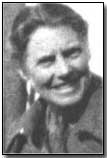 According to Joshua S. Goldstein
in War and Gender (2001) more than 25,000 American women intervened in the Great
War though Captain Barbara A. Wilson, USAF (Ret.), raises the figure to 30,000. In the impressive website she's devoted to the often unacknowledged presence of
American women in the armed forces, she writes that in relation to the Great War
that only then did "some parts of the government get serious about using woman
power." (link).
According to Joshua S. Goldstein
in War and Gender (2001) more than 25,000 American women intervened in the Great
War though Captain Barbara A. Wilson, USAF (Ret.), raises the figure to 30,000. In the impressive website she's devoted to the often unacknowledged presence of
American women in the armed forces, she writes that in relation to the Great War
that only then did "some parts of the government get serious about using woman
power." (link).
The USA already had Army (1901) and Navy (1908) Nurse Corps and Wilson puts at 13,000 the number of women who "enlisted in the Navy and the Marine Corps on the same status as men and wore a uniform blouse with insignia" during WWI. "With the war's end", she adds, "the Coast Guard Yeomanettes, along with their Navy and Marine Corps counterparts, were mustered out of the service. The War Department continued to thwart the Army's repeated requests for women to serve as clerks and consequently women other than nurses did not serve in the Army during World War I."
This is not quite correct, as the Signal Corps Women, 300 volunteers attracted by General Pershing's request for French-English bilingual long-distance telephone operators, did serve with the military, some 220 in France. The so-called 'Hello Girls' were subjected like military nurses to Army regulations, wore uniform and were sworn into the Army. However, as the daughter of one of them - Oleda Christides - explains, this was later denied for it would have given the women the rank of veterans. (link) Their service was acknowledged as late as 1978 to the only 70 survivors although without retroactive effects.
There were other women at the front, too: the French and Belgian women who saw their homes invaded by friendly and unfriendly troops - women of whom we know relatively very little - the professional entertainers and the also professional (or occasional) prostitutes. Joshua S. Goldstein comments that "women entertained troops not only with song and dance but with lectures, dramatic readings, and poetry." They "were treated chivalrously by troops, not as sex objects."
 Among these respected entertainers the most outstanding is possibly
Cicely Hamilton, actress and feminist playwright, founding mother of the
Actresses' Franchise League and the Women Writers' Suffrage League, and active
member of the Scottish Women's Hospitals Committee that backed Elsie Inglis's
work.
Among these respected entertainers the most outstanding is possibly
Cicely Hamilton, actress and feminist playwright, founding mother of the
Actresses' Franchise League and the Women Writers' Suffrage League, and active
member of the Scottish Women's Hospitals Committee that backed Elsie Inglis's
work.
Hamilton worked as a volunteer nurse in the Somme and as a postal overseer with the WAAC but spent the last years of the war touring the trenches with the repertory company she had been asked to form.
Hamilton would later write that she'd been appalled by the inhumanity of war while doing her best to entertain the troops. Possibly that was the attitude too of the many prostitutes employed near the front lines. Gary Mead writes in The Doughboy Centre (link) that "The French believed that the legalisation and control of prostitution were important and highly desirable, and they acted on that belief. The Americans believed that such measures were pernicious and most undesirable, and they acted on their belief."
The British just used what was available. Thus, Robert Graves recalls in Goodbye to All That (1929) the queues of British soldiers outside the licensed brothels run by the pragmatic French - those adorned with a blue light for officers, those with a red one for the troops - wondering whether the women were also of different types. Apparently, General Pershing was greatly concerned that his boys would fall prey to the VD killing thousands of French and British soldiers every day but not so much about the fate of the prostitutes. Ironically, the very people soldiers were supposed to be fighting for - women - were also, at least in this sense, the enemy.
Next - The Home Front: Suffrage and Work
The "linseed lancers" was the Anzac nickname assigned to members of the Australian Field Ambulance.
- Did you know?
